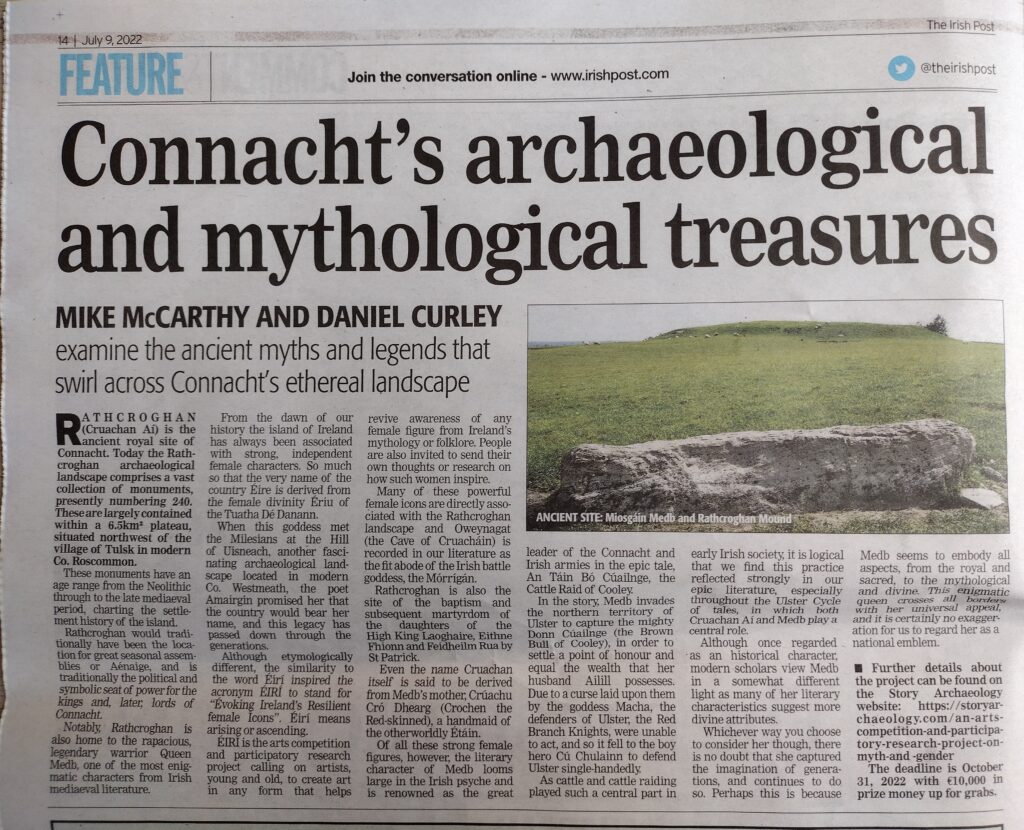By Mike McCarthy & Daniel Curley
An ÉIRÍ Competition article from the Irish Post : July 9th 2022

Mike McCarthy and Daniel Curley examine the ancient myths and legends that swirl across Connacht’s ethereal landscape
Rathcroghan (Cruachan Aí) is the ancient royal Site of Connacht. Today the Rathcroghan Archaeological Landscape comprises a vast collection of archaeological monuments, presently numbering 240. These are largely contained within a 6.5km² plateau, situated north-west of the village of Tulsk in modern Co. Roscommon.
These monuments range from the Neolithic through to the late Medieval Period, charting the settlement history of the island.
thcroghan would traditionally have been the location for great seasonal assemblies or Aénaige, and it is traditionally the political and symbolic seat of power for the kings and, later, lords of Connacht.
Notably, Rathcroghan is also home to the rapacious, legendary Warrior Queen Medb, one of the most enigmatic, iconic characters from Irish Medieval literature.
From the dawn of our history the island of Ireland has always been associated with strong, independent female characters. So much so that the very name of the country, Éire, is derived from the female divinity Ériu of the Tuatha Dé Danann.
When this goddess met the Milesians at the Hill of Uisneach, another fascinating archaeological landscape located in modern Co. Westmeath, the poet Amairgin promised her that the country would bear her name, and this legacy has passed down through the generations.
Although etymologically different, the similarity to the word Éirí inspired the acronym ÉIRÍ to stand for “Évoking Ireland’s Resilient female Ícons”. Éirí means “arising” or “ascending”.
ÉIRÍ is the arts competition and participatory research project calling on artists, young and old, to create art in any form that helps revive awareness of any female figure from Ireland’s mythology or folklore. People are also invited to send their own thoughts or research on how such women inspire.
Many of these powerful female icons are directly associated with the Rathcroghan landscape and Oweynagat (the Cave of Cruacháin) is recorded in our literature as the fit abode of the Irish Battle Goddess, the Mórrígán.
Rathcroghan is also the site of the baptism and subsequent martyrdom of the daughters of the High King Laoghaire, Eithne Fhionn and Feidheilm Rua by St. Patrick and even the name Cruachan itself is said to be derived from Medb’s mother, Crúachu Cró Dhearg (Crochen the Red-skinned), a handmaid of the otherworldly Étáin.
Of all these strong female figures, however, the literary character of Medb looms large in the Irish psyche and she is known to one and all as the great leader of the Connacht and Irish armies in our National Epic tale, An Táin Bó Cúailnge, Cattle Raid of Cooley.
In the story of this great raid, she invades the northern territory of Ulster to capture the mighty Donn Cúailnge (the Brown Bull of Cooley), in order to settle a point of honour and equal the wealth that her husband Ailill possesses. Due to a curse laid upon them by the goddess Macha, the defenders of Ulster, the Red Branch Knights, were unable to act, and so it fell to the boy hero Cú Chulainn to defend Ulster single-handedly.
As cattle and cattle raiding played such a central part in early Irish society, it is logical that we find this practice reflected strongly in our epic literature, especially throughout the Ulster Cycle of tales, in which both Cruachan Aí and Medb play a central role.
Although once regarded as an historical character, modern scholars view Medb in a somewhat different light as many of her literary characteristics suggest more divine attributes.
Whichever way you choose to consider her though, there is no doubt that she captures the imagination of generations. Perhaps this is due to the fact that Medb seems to embody all aspects, from the royal and sacred, to the mythological and divine. This enigmatic queen crosses all borders with her universal appeal, and it is certainly no exaggeration for us to regard her as a national emblem.
Further details about the project can be found on the Story Archaeology project website page
The deadline is 31 October with €10,000 in prizemoney.
